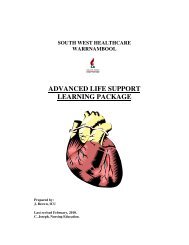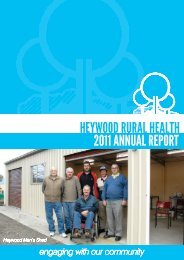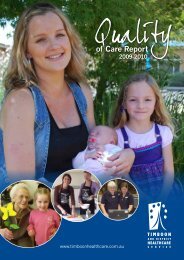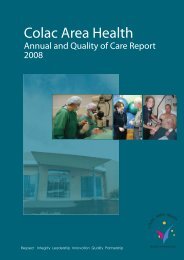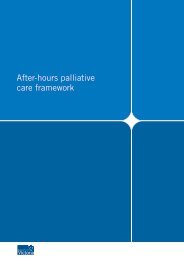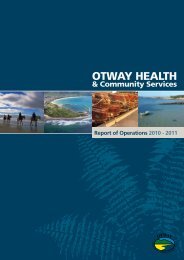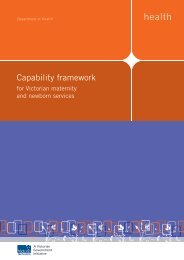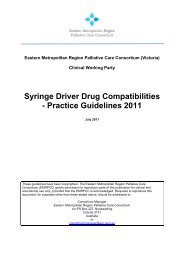Self Directed Learning Package - University of Queensland
Self Directed Learning Package - University of Queensland
Self Directed Learning Package - University of Queensland
- No tags were found...
Create successful ePaper yourself
Turn your PDF publications into a flip-book with our unique Google optimized e-Paper software.
80 • The Palliative Approach ToolkitKey PointResidents may <strong>of</strong>ten have more than one type andlocation <strong>of</strong> pain. This is especially common withadvanced cancer pain.The following story illustrates a resident with advanced diseasewhere metastases are causing pain in three different locations.Case Study: JudyJudy (87 years) has been a resident <strong>of</strong> your facility for 4months and is dying.She was diagnosed with advanced bowel cancer threemonths ago and her disease has progressed rapidly. She hasdeveloped a fungating rectal mass as well as metastasis inher liver and bones (right hip and ribs). She complains <strong>of</strong> painin her ‘bottom’ when she is sitting on a chair, intermittent hippain when she walks or moves in bed and also a ‘discomfort’in the right upper quadrant <strong>of</strong> her abdomen occasionallyradiating to her right shoulder.The areas <strong>of</strong> pain identified in this case study include her rectallesion, bone pain (worse on movement), and pain from her livercausing referred pain to her shoulder.Barriers to effective pain assessment andmanagementThinking PointWhat factors may interfere with Judy’s painassessment?Barriers to indentifying pain• concurrent clinical problems• cognitive impairment• multiple pain problems• lack <strong>of</strong> objective biological markers for chronic pain that canbe used to test if pain is present• communication deficitse.g. language, vision, dysphasia• cultural norms in the expression <strong>of</strong> paine.g. Western Anglo-Saxon “stiff upper lip”• false beliefse.g. “People with dementia don’t feel pain”; “It’s normal tohave some pain as you age”; “Opioids hasten death”• fear <strong>of</strong> the meaning <strong>of</strong> pain especially when linked to canceror a terminal illness• inexperience <strong>of</strong> healthcare workers in OBJECTIVE assessment<strong>of</strong> pain. 2



